

| The Horse Chestnut Leaf Miner in Nottinghamshire |
| This highly invasive moth first appeared in the county, when leaf mines were discovered on the lower branches of a Horse Chestnut (Aesculum hippocastanum) growing within the grounds of Nettleworth Manor near Mansfield Woodhouse in July 2007. | ||
| ..... | ||
| The following months saw
the discovery of further leaf mines at most other sites
we visited and 2008 saw the continued spread of the moth
and increased infestation levels at known sites from the
previous year. The Horse Chestnut Leaf Miner (Cameraria ohridella) has since continued its spread and mines are probably on every Horse Chestnut in Nottinghamshire by now (2015). From early July onwards, Horse Chestnut trees are conspicuous for their brown, withered-like leaves, caused by hundreds of leaf mines per leaf. This gives the impression that Autumn is arriving earlier as a result. Surprisingly though, it seems that the effects on infested trees are still purely cosmetic. Whether infested trees can continue to generate new foliage over successive years with no adverse effects, remains to be seen. |
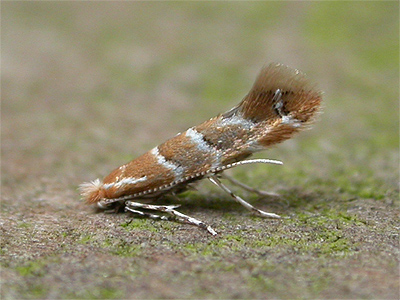 |
|
| ..... | ||
| Discovery
and spread of the Horse Chestnut Leaf Miner in Europe The Horse Chestnut Leaf Miner (Cameraria ohridella) was only discovered near Macedonia as recently as 1985, although it was originally known from Greece in the 1970's, but not recognised as a separate species until 1985. It then spread rapidly to other European countries, before reaching the UK (at Wimbledon, south-west London) in 2002, but was considered likely to have arrived the previous year due to the number of mines found. Accidental transportation via either road or rail, was thought to be a contributing factor in helping the moth reach the UK. |
||
| ..... |
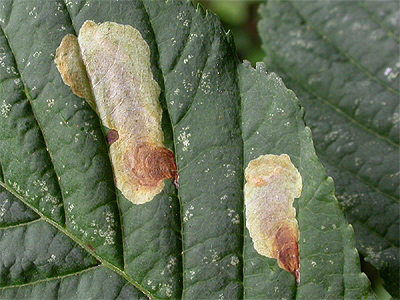 |
Since 2002, it has spread
over much of the southern UK and had already reached the
neighbouring counties of Derbyshire and Leicestershire by
2005. The first Nottinghamshire record After weeks of searching at various sites, we finally discovered several occupied C. ohridella mines on a Horse Chestnut situated in the grounds of Nettleworth Manor near Mansfield Woodhouse on July 9th 2007. The mines all seemed to be below a height of about 2 metres and most were on foliage growing in sheltered locations, often well under the tree canopy and in shade. Side shoots from the trunk were also affected. Following checks with other UK entomologists, it was revealed that there were in fact no Nottinghamshire records of this invasive moth to date and the Nettleworth record was later confirmed as Nottinghamshire's first by John Langmaid. |
|
| ..... | ||
| We made a more accurate
count of the number of mines present at Nettleworth Manor
the following morning, reaching around 15/20 mines on the
two Horse Chestnuts present. Further searches were
conducted and we found increased numbers of mines on
three other trees nearby. Within just a few days of the original discovery, low-level infestations were found at Attenborough by Richard Rogers and in the Mapperley, Daybrook and Arnold areas of Nottingham by ourselves. It is possible that the moth may have been noted in Wollaton Park during 2006, but no supporting evidence was produced and the record could not be verified. In the north of the county, more mines were quickly found at both Carburton and two sites in central Worksop. Rob Johnson also discovered mines to be common in the Southwell area. |
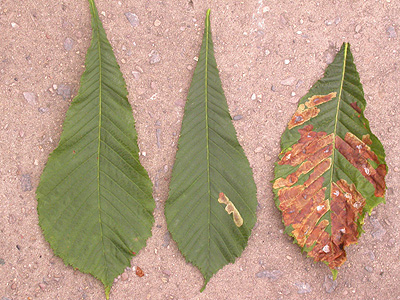 |
|
| ..... | ||
| The moth was
obviously extremely widespread throughout Nottinghamshire
in 2007, but generally at a fairly low infestation rate
based on evidence produced at the time. However, higher
infestation rates were then discovered at Oxton,
suggesting that C. ohridella had definitely
arrived there in 2006 and probably by 2005. The trees in
the centre of Oxton were found with an infestation rate
of a minimum of 250 mines per tree. At the end of July, trees with a considerably higher rate of infestation than that at Oxton were found at Caunton, where the number of mines per leaf ranged from a single mine to well over 25 to a single leaf. On many leaves, around 60-75% of the surface area was affected. Three leaves showing different levels of C. ohridella infestation, are shown in the above photograph. The middle leaf was fairly typical of the low-level infestations found at most of the sites surveyed at the end of July 2007, but the leaf on the far right was representative of high-level infestations on trees at Caunton, which had the highest level of infestation found during 2007. |
||
| ..... | ||
| Infestation
levels at Caunton in 2008 Of the locations checked in 2007, trees at Oxton and Caunton had much higher levels of C. ohridella infestation than anywhere else. But it was believed at the time, that many south-east Nottinghamshire sites would have shown infestations of similar levels. An appeal at the time for records from this part of the county proved to be unsuccessful, so this was never confirmed. A year on and a return visit to Caunton in mid-September 2008, showed just how quickly infestation levels have increased. Large proportions of the lower branches of the same trees, were now almost devoid of any green leaf area following a succession of broods throughout the year. There was also evidence that leaves higher up the trees were also becoming more heavily infested as females searched for suitable egg laying sites. |
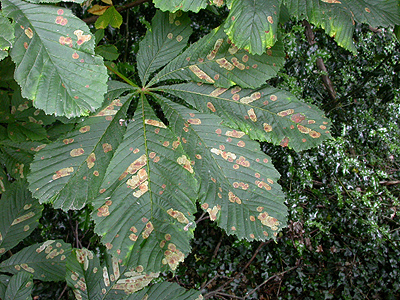 |
|
| ..... | ||
| Right :- Cameraria ohridella mines on Horse Chestnut at Caunton in 2007. Below left :- A wider view of the same Horse Chestnut tree in September 2008, showing the huge number of Cameraria ohridella mines present. Below right :- Larva within leaf mine. | ||
| ..... | ||
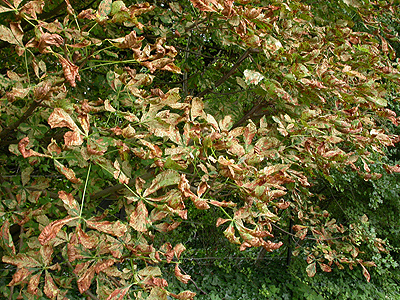 |
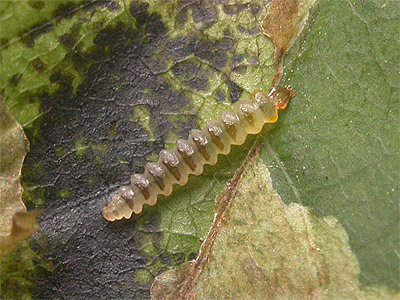 |
|
| ..... | ||
| Cameraria
ohridella infestation levels across
Nottinghamshire since 2010 2010 saw a continued and dramatic rise in the levels of C. ohridella infestation throughout Nottinghamshire and even self-sown saplings and isolated roadside trees several miles from other Horse Chestnuts, were affected. By late July, many trees now show some signs of defoliation to their lower branches. Previously unaffected sites such as at Edwinstowe and Debdale Lane in Mansfield (which had remained free of the moth until 2009) were found to have infestation levels more or less in line with those found at Oxton and Caunton back in 2007. The sharp rise in infestation levels is possible because the moth is triple-brooded within a single year, so the multiples of population increases are huge following the first appearance of mines on any tree. Now on warm sunny days, heavily infested trees and the immediate vegetation can be literally swarming with several hundred adults. The latest distribution map we have available (2015), shows that C. ohridella has now reached most parts of the county. Its really only down to the lack of observer coverage and reporting, that means some parts of Nottinghamshire still appear to remain unaffected by the moth. Records for the Nottinghamshire distribution map are currently provided by the following contributors - Trevor and Dilys Pendleton. Lound Moth Group. Richard Rogers. Wil Heeney. Jerry Clough. Nottinghamshire Wildlife Trust. Tim Sexton. Potential Horse Chestnut tree damage The long-term threat of C. ohridella infestation, to one of our most easily recognised trees is not fully understood and the moth's rapid colonisation of the UK, has been closely monitored by the Forestry Commission. |
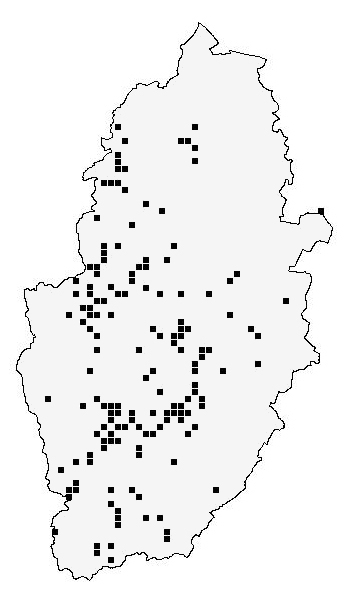 |
|
| ..... | ||
| Current evidence suggests that there is no decline in tree health and that trees are capable of producing new growth later in the year. Trees seem to survive repeated infestations with no effects and the damage is largely cosmetic. Most damage occurs too late in the growing season to adversely affect the health of the tree. Horse Chestnut trees of the red flowering variety are still less affected than the more common white flowering Horse Chestnut. | ||
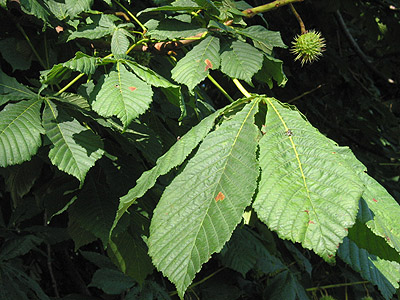 |
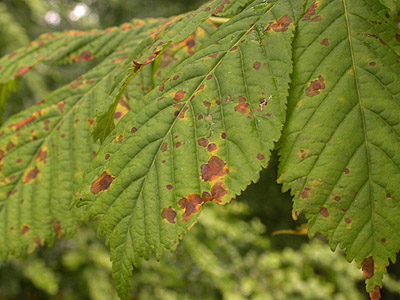 |
|
| Above left :- Cameraria ohridella mines on Horse Chestnut at Nettleworth Manor, photographed on discovery in early July 2007. By September 2010, leaves on the same tree were virtually brown with hundreds of mines. Above right :- leaf blotches caused by a fungal infection. These become larger and more obvious as the season progresses. | ||
| ..... | ||